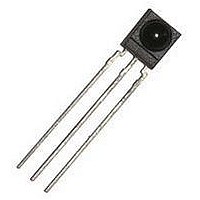TSOP4838 Vishay, TSOP4838 Datasheet - Page 5

TSOP4838
Manufacturer Part Number
TSOP4838
Description
Infrared Receivers 4.5-5.5V 38kHz
Manufacturer
Vishay
Specifications of TSOP4838
Carrier Frequency
38 KHz
Supply Current
0.85 mA
Beam Angle
45 deg
Data Transmission Rate
800 bits/s
Mounting Style
Through Hole
Transmission Distance
45 m
Viewing Angle
45 deg
Output Current
5 mA
Operating Voltage
2.7 V to 5.5 V
Power Dissipation
10 mW
Maximum Operating Temperature
+ 85 C
Minimum Operating Temperature
- 25 C
Transmission Range
45m
Directivity
45°
Supply Voltage Range
2.7V To 5.5V
Opto Case Style
Through Hole
Operating Temperature Range
-25°C To +85°C
Svhc
No SVHC
Rohs Compliant
Yes
Lead Free Status / RoHS Status
Lead free / RoHS Compliant
Lead Free Status / RoHS Status
Lead free / RoHS Compliant, Lead free / RoHS Compliant
Available stocks
Company
Part Number
Manufacturer
Quantity
Price
Part Number:
TSOP4838
Manufacturer:
VISHAY/威世
Quantity:
20 000
Company:
Part Number:
TSOP4838LL1
Manufacturer:
WYC
Quantity:
23 470
Company:
Part Number:
TSOP4838SB1
Manufacturer:
VIS
Quantity:
1 353
Company:
Part Number:
TSOP4838SB1
Manufacturer:
ESIC
Quantity:
30 000
Company:
Part Number:
TSOP4838SJ1
Manufacturer:
FS
Quantity:
984
Company:
Part Number:
TSOP4838UH1
Manufacturer:
EPCOS
Quantity:
1 000
Suitable Data Format
The circuit of the TSOP48.. is designed in that way
that unexpected output pulses due to noise or distur-
bance signals are avoided. A bandpass filter, an inte-
grator stage and an automatic gain control are used
to suppress such disturbances.
The distinguishing mark between data signal and dis-
turbance signal are carrier frequency, burst length
and duty cycle.
The data signal should fulfill the following conditions:
• Carrier frequency should be close to center fre-
quency of the bandpass (e.g. 38 kHz).
• Burst length should be 10 cycles/burst or longer.
• After each burst which is between 10 cycles and 70
cycles a gap time of at least 14 cycles is necessary.
• For each burst which is longer than 1.8 ms a corre-
sponding gap time is necessary at some time in the
data stream. This gap time should be at least 4 times
longer than the burst.
• Up to 800 short bursts per second can be received
continuously.
Some examples for suitable data format are: NEC
Code (repetitive pulse), NEC Code (repetitive data),
Toshiba Micom Format, Sharp Code, RC5 Code,
RC6 Code, R-2000 Code, Sony Code.
When a disturbance signal is applied to the TSOP48..
it can still receive the data signal. However the sensi-
tivity is reduced to that level that no unexpected
pulses will occur.
Some examples for such disturbance signals which
are suppressed by the TSOP48.. are:
• DC light (e.g. from tungsten bulb or sunlight)
• Continuous signal at 38 kHz or at any other fre-
quency
• Signals from fluorescent lamps with electronic bal-
last with high or low modulation ( see Figure 13 or Fig-
ure 14 ).
Document Number 82090
Rev. 11, 23-Jun-03
VISHAY
Figure 14. IR Signal from Fluorescent Lamp with high Modulation
Figure 13. IR Signal from Fluorescent Lamp with low Modulation
16920
16921
0
0
IR Signal from fluorescent
lamp with high modulation
IR Signal from fluorescent
lamp with low modulation
5
5
Time ( ms )
Time ( ms )
10
10
Vishay Semiconductors
15
15
TSOP48..
20
20
www.vishay.com
5








